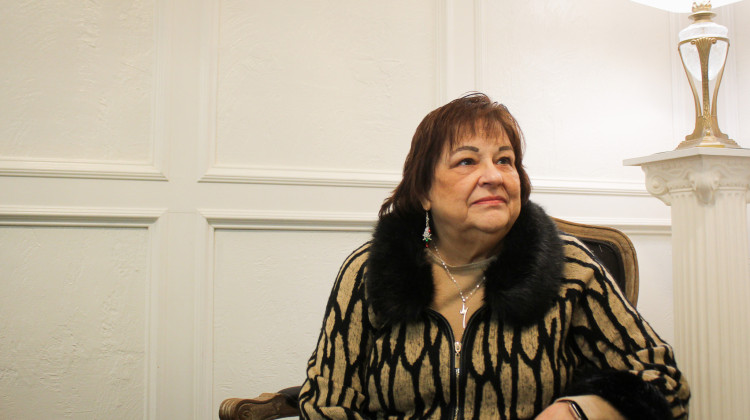
Indiana’s state fair will bring animals from across the state together. Experts say it poses a risk for the spread of bird flu.
Ben Thorp / WFYIBetween July and October states across the country hold their annual state fairs.
The events are known for things like Ferris wheels and corn dogs, sculptures made entirely from butter and the biggest pig in the state. But state fairs can also be places where it’s easier to spread disease –– bringing humans and animals from farms across the state into close contact.
That’s of particular concern this year, as H5N1 or bird flu infections have been confirmed in dairy cattle in 13 U.S. states for the first time ever. The virus has also infected four dairy workers across Michigan, Texas, and Colorado.
But that’s not keeping many fairgoers from lining up in front of the cattle nosing their way out of their barn fences.
Mel Ventimiglia stood by several cows with his grandkids inside a barn at the Indiana State Fair in Indianapolis. He said bird flu isn’t even on his radar.
“I haven’t heard anybody mention it except for you,” he told Side Effects. “Hopefully, I forget about it pretty quickly.”
At another nearby cattle barn, farmer Randy Mason says he follows basic precautions to keep his cattle from getting sick while at the fair, but he’s not particularly worried.
“A lot of that in my opinion gets overblown,” he said. “They get one or two cases and then it becomes –– like everything the government does –– it becomes overblown and out of proportion.”
But across the country, bird flu infections have been confirmed in nearly 200 herds, according to the Centers for Disease Control and Prevention.
That’s led officials at some state fairs to enact stricter rules to keep the virus from spreading.
In Minnesota, which has detected cases of bird flu within its dairy cattle, the state is requiring all cows to have a negative bird flu test before coming to the state fair.
That’s not the case in many other states, however, including Indiana, where there hasn’t been confirmed cases of bird flu.
“Since we've not had a diagnosis, we've not put those additional measures,” said Bret Marsh, Indiana state veterinarian.
He said the state has told farmers to keep an eye out for signs of bird flu in their animals. They have also communicated to farmers the risks of spreading illness when coming to the fair and advised that animals are quarantined for 30 days after being shown –– but without a positive test, Marsh said, the state doesn’t need to put tighter restrictions in place.
Why are state fairs a concern?
But scientists widely agree that there is not enough testing going on to fully understand which states have cows infected with bird flu.
Amesh Adalja, a senior scholar at the Johns Hopkins Center for Health Security, said states like Indiana don’t have any positive bird flu cases in cattle because they aren’t looking for them.
“The assumption should be, this virus is in the state of Indiana, we just haven't found it yet,” he said. “That's what they should be messaging, not ‘Our cows are free.’ That's foolish to believe.”
That makes sites like state fairs –– where humans will be coming into contact with different animals –– especially concerning. Scientists worry that the bird flu could mutate to become a human virus if given the opportunity.
Currently, the virus seems to only have infected humans coming in direct contact with the udders and equipment used on infected cows, and have resulted in cases of conjunctivitis or pink eye in humans. The broader concern is that the virus could mutate into a respiratory virus which would spread more easily from person to person.
And fairs have a history of being places where that spillover –– from animals to humans –– happen.
In 2012 a major swine flu outbreak led to over 300 infections in the U.S., with the majority of those associated with exposure at agricultural fairs. And last year, the CDC reported that two people caught swine flu after visiting pig exhibits.
Each time an influenza virus jumps into a new host it’s given an opportunity to evolve, potentially becoming one that could easily spread through humans.
Experts worry that the risk of H5N1 becoming a human virus could be substantially heightened if the virus makes it to pigs in particular because they are a perfect mixing vessel for viruses from different species. This means that the different viruses can exchange genetic material and learn from one another, potentially mutating and becoming more adept at infecting humans.
“One of the things that people bring up so much about Covid-19 are the animal markets in China, where you have multiple different animals and different species interacting with each other,” Adalja said. “Similar things happen at state fairs in the United States. That's not really any different.”
Andrew Bowman, professor of veterinary preventive medicine at the Ohio State University, agrees that the co-mingling of animals and people at state fairs poses a risk.
“We've thought about new pandemic viruses arising from Southeast Asian live animal markets. And we think, ‘Oh, we would never do that in the U.S.’ Well, fairs kind of mimic that,” he said.
The risk to humans is still low
Still, experts like Bowman say that isn’t a reason to miss out on the state fair altogether.
“I'm still going to the fair, and my family is still going to the fair. I had a milkshake when I was there,” Bowman said.
He added that at-risk populations, such as the immunocompromised, should consider avoiding the cattle barn this year.
“You know, exercise caution and really kind of think about which contacts [you] need to have,” Bowman said. “Can I enjoy the animal exhibits, maybe from a little further distance, and not get right in the middle of it?”
The CDC issued guidance in June for state fairs to reduce the spread of bird flu, including a prohibition on dumping milk on the ground, because raw milk from infected cattle is likely to carry live virus. The guidance also advises keeping cows from different herds apart, and encourages visitors to wash their hands before leaving a barn.
Earlier this year the U.S. Department of Agriculture instituted a rule requiring cows test negative for the virus before crossing state lines.
Still, the risk to humans from the bird flu virus remains low, according to the CDC’s assessment.
Side Effects Public Media is a health reporting collaboration based at WFYI in Indianapolis. We partner with NPR stations across the Midwest and surrounding areas — including KBIA and KCUR in Missouri, Iowa Public Radio, Ideastream in Ohio and WFPL in Kentucky.
 DONATE
DONATE







 Support WFYI. We can't do it without you.
Support WFYI. We can't do it without you.